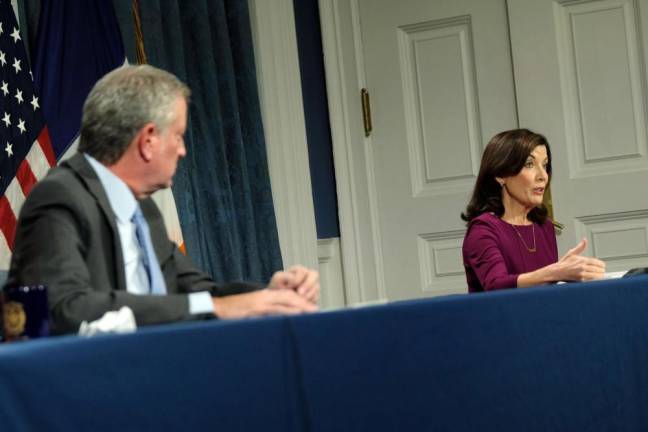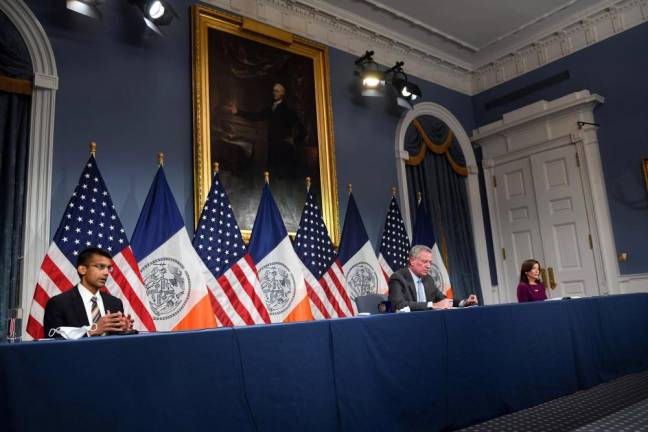When fear runs high and facts are scarce, it’s wise to go back to what you already know works.
That, boiled down, were the instructions from health officials as they greeted the identification in New York of a new variant of the SARS-CoV-2 virus, dubbed Omicron.
“Let’s maintain precautions,” said Dr. Bruce Y. Lee of the CUNY School of Public Health.
“Face mask wearing, social distancing. That hasn’t changed even with the Omicron variant. We should still be doing the same things. If we continue to wear face masks and social distance, it doesn’t matter how transmissible the virus is. If it can’t reach you. it can’t reach you.”
This straightforward advice was echoed by many other health officials, who stressed that we don’t know enough about the properties of this variant to even yet know whether to be seriously alarmed. It is even possible Omicron will turn out to be a positive development, some experts said.
But this wait-and-see advice seemed at times to be overshadowed by the visuals of public officials who, having been accused of doing too little, too late in early stages of this pandemic, seemed eager to show they were acting. And when the president, the governor and the mayor all tell you not to panic, there is a natural tendency to, well, get at least a little anxious.
On Monday Mayor Bill De Blasio announced what he characterized as the most aggressive vaccine mandate in the country, requiring every private employer to assure their staff is vaccinated. He called this a “preemptive strike” against a winter wave of COVID-19 that has been building since November 1, even before Omicron’s arrival.
President Biden has tried to impose a vaccine mandate on private employers, but it is stalled in court. The mayor said he was sure his order would withstand legal challenge.
City Hall said the mandate would cover roughly 184,000 private businesses. As of this weekend, one adult New Yorker in ten remains unvaccinated. The mayor also expanded the vaccination requirements for indoor dining to require two doses, not one, and to cover kids, who only recently became eligible.
“About Unity”
The Omicron variant seemed already to have produced one positive effect, as Governor Kathy Hochul and de Blasio presented a COVID era shoulder-to-shoulder look at a joint press conference last Thursday that her predecessor rarely presented with his nemesis, the mayor.
“This is about unity,” she said.
So eager were they to be united and transparent that the mayor and governor held the joint press conference to share that five cases of omicron had been identified in New York City and Long Island, and then very little other information.
“A very important moment as we’re getting information about the first Omicron variant case here in New York City,” the mayor imparted.
The governor said she and the mayor were there to “make sure that we share information real time with the constituents of our city and our state.”
The challenge of course is there isn’t much information. The governor and Mayor called the press conference to say that four cases had been identified in New York City and one on Long Island. They admitted they didn’t know much else, other than the obvious point that the variant was here and likely spreading in the community.
Looking at Mutations
Which brings us back to the calm advice of Dr. Lee. He is an expert on how epidemics spread. He builds computer models to study this.
Mutating is what viruses do, he points out. The issue is whether the mutations change the way the virus interacts with us. Scientists can make educated speculations by looking at the mutations. But to really know, they have to watch and see what happens, which takes time.
For example, this variant seems likely to be more transmissible than the original variant first identified in Wuhan, China. But is it more transmissible than Delta, the currently dominant variant in New York and much of the world?
“The omicron #SARS2 variant is probably roughly as transmissible or somewhat more transmissible than the delta variant,” reports Dr. Nicholas A. Christakis, the Sterling Professor of Social and Natural Science, Internal Medicine & Biomedical Engineering at Yale University.
“The Wuhan strain had an R0 of 3, the delta variant an R0 of 6, and the omicron might have an R0 in the range of 4-8. I am very confident about this feature.”
The R0, in case you need a refresher, is the average number of cases each infected person spreads to others. The higher the R0 the higher the proportion of the population that needs to be vaccinated to bring the pandemic under control, Lee noted.
But transmissibility is only one of the three qualities of the virus that researchers are working furiously to understand. The second is whether Omicron is better able than past variants to evade the immunity the body develops from past infections or vaccination.
A lot has been said about this and very little is yet known for certain, although most experts expect vaccinations to still be effective. We just don’t know how effective, as the president of Moderna noted.
Which is why everyone from the President down are urging everyone to get vaccinated and boosted.
Mild Cases
The third quality is how deadly this variant is. Public officials are quick to note that cases so far appear to be mild. Whether that is truly a quality of the variant or just the result of who so far has gotten infected will not be clear for awhile.
But Lee notes that it is at least possible this variant could be less lethal than, say, Delta. If that were the case, and it was equally or more transmissible, it might shoulder Delta out of dominance and thus reduce the rate of serious illness and death.
Which is a good place to note that while Omicron may loom, Delta is here and infecting an average of close to 1,500 New Yorkers a day.
“Variants are going to be a fact of this pandemic,” Lee noted.
What is crucial, he said, is clearer communication on the importance of maintaining measures that suppress the spread of the virus in all its variants.
“One of the challenges is there hasn’t been consistent messaging.”
Back in May, he pointed out, officials began saying it was OK to reduce face mask use and social distancing for those who were fully vaccinated.
“Many people abandoned it whether they were vaccinated or not,” Lee said.
Executive Order
So the surge we are currently experiencing can be attributed as much to loosening of safety measures as to the Delta variant, he said.
While de Blasio has repeatedly said that vaccination is the whole ballgame when it comes to defeating COVID-19, his health commissioner, Dr. Dave Chokshi, struck a broader note in an executive order a few days before the first cases of Omicron were found here.
“COVID-19 infection is transmitted predominately by inhalation of respiratory droplets and studies show that masks and face coverings block the release of respiratory droplets into the environment and can also reduce the wearer’s exposure to droplets from others because COVID-19 viral particles spread between people more readily indoors and when people are closer together for longer periods of time indoors,” Chokshi’s order said.
“The WHO and the U.S. Centers for Disease Control and Prevention have advised all individuals to take measures to reduce their risk of COVID-19, especially the Delta and Omicron variants, including proven public health and social measures such as wearing well-fitting masks, hand hygiene, physical distancing, improving ventilation of indoor spaces, avoiding crowded spaces, and getting vaccinated.”
Dr. Bruce Y. Lee of CUNY School of Public Health notes it is at least possible this variant could be less lethal than Delta. If that were the case, and it was equally or more transmissible, it might shoulder Delta out of dominance and thus reduce the rate of serious illness and death.

